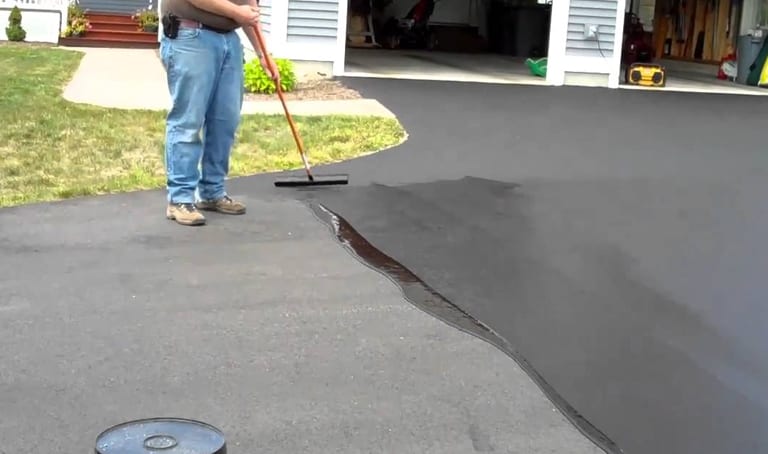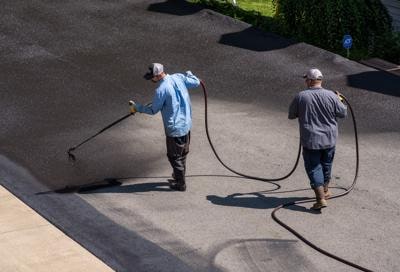Change Your Building's Aesthetic appeals: Commercial Parking Area Paving and Asphalt Sealing Solutions
Change Your Building's Aesthetic appeals: Commercial Parking Area Paving and Asphalt Sealing Solutions
Blog Article
Hot Mix Asphalt: A Sustainable Solution for Pavement
Hot Mix Asphalt (HMA) has actually become a leading lasting selection for sidewalk options, providing a myriad of cutting-edge innovations and environmental benefits. Its ability to decrease and reuse materials power consumption provides an engaging instance for its adoption in roadway building jobs. Furthermore, the long-lasting performance and sturdiness of HMA make it a preferred option for framework development. As the need for green building and construction techniques expands, checking out the nuances of HMA's sustainability can provide valuable insights into the future of pavement services.
Environmental Benefits of Hot Mix Asphalt

Moreover, Warm Mix Asphalt assists to mitigate city heat island impacts. Its dark shade absorbs sunlight, decreasing the amount of warm showed back into the atmosphere compared to lighter-colored sidewalks. This can lower ambient temperatures in metropolitan locations, reducing the demand for cooling and ultimately decreasing energy consumption.
Additionally, Warm Mix Asphalt contributes to enhanced stormwater monitoring. Its permeable nature permits water to reenergize and penetrate the sidewalk groundwater products, minimizing drainage and the threat of flooding. These ecological benefits make Warm Mix Asphalt a sustainable option for leading freeways and roadways.
Energy Effectiveness in HMA Production
Is energy efficiency a critical aspect in the manufacturing of Hot Mix Asphalt (HMA)? Energy plays a significant role in the production of HMA, affecting both expense and ecological sustainability. One key element of energy effectiveness in HMA manufacturing is the usage of warm mix asphalt (WMA) technologies.
Additionally, innovations in plant modern technologies have led to more energy-efficient HMA manufacturing procedures. Modern plants are made with features like recycled asphalt pavement (RAP) processing abilities, reliable burner systems, and boosted insulation, all contributing to energy financial savings. By optimizing power use in HMA production, the industry can minimize its carbon footprint while keeping high-quality sidewalk materials. Energy performance is, consequently, a vital consideration in ensuring the sustainability of Warm Mix Asphalt manufacturing.
Recyclability of Hot Mix Asphalt
The recyclability of Hot Mix Asphalt (HMA) is a pivotal element of its sustainability and long-lasting ecological effect. HMA is just one of the most recycled materials in the United States, with over 100 million lots of reclaimed asphalt pavement (RAP) being reused yearly in brand-new sidewalk building. Reusing HMA supplies several ecological advantages, such as minimizing the demand for virgin materials, lowering energy usage throughout production, and reducing the amount of waste sent to garbage dumps.
The process of reusing HMA includes grating the existing sidewalk, crushing it into smaller pieces, and mixing it with brand-new accumulation and asphalt binder to create a recycled mix. This recycled mix can typically perform as well as and even far better than standard HMA, while calling for less resources and producing lower greenhouse gas discharges. By integrating RAP right into new pavement jobs, road agencies can preserve natural deposits, reduce costs, and minimize the ecological impact of roadway building and construction and upkeep activities. In general, the recyclability of HMA plays a substantial role in promoting sustainable practices within the sidewalk market.

Long-Term Performance of HMA
Asphalt sidewalks demonstrate durability and durability over an extensive duration, mirroring the long-term performance of Hot Mix Asphalt (HMA) In addition, developments in HMA innovation, such as the use of polymer-modified binders and cozy mix asphalt, have further improved the resilience and durability of HMA pavements. By focusing on quality building and construction and upkeep techniques, HMA continues to prove itself as a click here for more cost-efficient and sustainable solution for durable sidewalk framework.

HMA: Toughness and Sustainability
Demonstrating both sturdiness and sustainability, Warm Mix Asphalt (HMA) has actually come to be a cornerstone in the construction of resilient pavement frameworks - regrading. HMA's sturdiness comes from its ability to withstand heavy loads, harsh climate condition, and high website traffic quantities, making it a reputable option for highways, freeways, and airport paths. The structure of HMA, which generally includes accumulations, binder, and filler, plays a critical function in enhancing its durability and find more resistance to tear and wear
Additionally, HMA's sustainability hinges on its recyclability and energy-efficient manufacturing process. The ability to reuse recovered asphalt sidewalk (RAP) in brand-new HMA mixtures lowers the need for virgin products and decreases the environmental influence of pavement building and construction and upkeep. Additionally, the energy performance of creating HMA depends on its reduced blending temperatures contrasted to other pavement materials, resulting in minimized energy usage and greenhouse gas emissions.
Verdict
In conclusion, hot mix asphalt (HMA) supplies a sustainable remedy for pavement with its eco friendly characteristics. HMA's recyclability, energy effectiveness in production, and lasting longevity make it an eco-friendly choice for road building and construction.
HMA is one of the most recycled materials in the United States, with over 100 million heaps of reclaimed asphalt pavement (RAP) being recycled yearly in new pavement construction.The process of reusing HMA involves milling the existing pavement, squashing it right into smaller items, and mixing it with new accumulation and asphalt binder to produce a recycled mix.Asphalt pavements demonstrate sturdiness and resilience over an extended period, showing the long-lasting efficiency of Warm Mix Asphalt (HMA) Additionally, improvements in HMA modern technology, such as the usage of polymer-modified binders and cozy mix asphalt, have actually better boosted the resilience and durability visit our website of HMA sidewalks. The capacity to recycle reclaimed asphalt pavement (RAP) in new HMA mixes minimizes the need for virgin products and reduces the environmental influence of pavement building and construction and upkeep.
Report this page